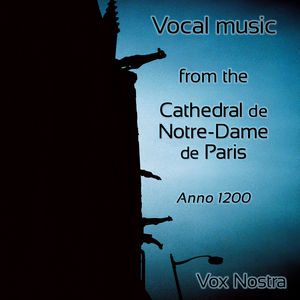
Vocal music of the Cathedral Notre-Dame de Paris in the year 1200
Details
- Field of Interest
- Classical Music
- Description
- Vocal music from the Cathedral de Notre-Dame de Paris, anno 1200.
Paris, 1163. The construction of the Cathedral Notre-Dame in innovative gothic style was underway. The exactness of proportion was the foundation of both the architecture, as well as the music of the late Middle Ages. The spatial conception found in the architecture of gothic cathedrals was mirrored in new compositional techniques. A layering of up to four individual voices superimposed upon one another is found in the liturgical music of the late 12th century. The art historian Otto von Simson referred to the overwhelming special conception of gothic cathedrals as "music turned into stone".
By the year 1200, the cathedral had become a radiant cultural and academic center. Cathedral and monastery school collegiums were the breeding grounds of academia. At the beginning of the 13th century, 'musica' was taught in the University as one of the seven liberal arts - geometry, arithmetic, music, astronomy, rhetoric, grammar, and dialectic. Music was closely related to the concept of cosmic arrangement in number and proportion, shedding light on the early notion of music as 'audible number', and later as 'numbered sound'. The cathedral school must have been a magnet for general interest as well. Music was performed there, which was not heard anywhere else in Europe. People came in torrents to experience the flourishing of this new incredible music. Performed primarily on high feast days of the church calendar in celebratory and magnificent musical implementation, the music included the use of polyphony. At feasts of the highest liturgical importance, the new vocal compositions could be heard with up to four voices.
The names of two magistri, Leonius and Perotinus, are known to us today in conjunction this early form of polyphony. They achieved international fame as teachers and cantors in the Seine metropolis . According to the celebrated chronicler Anonymous IV, curious students and clerics traveled to Paris from Italy, England, and Spain, to hear the spectacular new musical art with their own ears, and to study this new compositional technique.
The impact of this innovation was extraordinary. Imagine the magnificent stained glass windows, creating paintings of light in the gothic church. The church space was also filled with the sound of disembodied voices, as the singing clerics in the presbytery were separated from the laypeople in the nave of the church by a chancel screen made of fabric or carpets. The charisma of these sumptuous and rare church feasts was immense. For a medieval person, the sacred construction of the presbytery had a deeply felt symbolism, the embodiment of 'heavenly Jerusalem'. The celestial sound of the 'laus perhennis', or 'everlasting praise' soared out from behind the chancel screen. If a believer had the chance to hear these musical prayers radiating from such a holy place, sung at times by more than one hundred clerics in such splendor, his or her chance of salvation would certainly improve.
Highly trained clerics and boy singers spent many years of study in order to sing the complex polyphonic music. Boy singers had to pass very stringent singing tests for this purpose. A new repertory with new musical forms was developed in the cathedral schools- organum, conductus, and motet.
In this time all over central Europe, monumental gothic cathedral buildings were erected. Likewise, the music from Notre- Dame circulated through manuscript copies of the famous Magnus Liber Organi de Graduali et Antiphonario (Book of Graduals and Antiphons). This book is a collection of polyphonic compositions (organa) for parts of the Mass and Divine Office: alleluia, gradual, responsories, and benedicaumus Domino. The beginnings and the verses, which earlier were solistically sung, appeared in a polyphonic vestment. The practice of singing organum, which in early times was a purely improvisational technique, comprised of inventing a second voice to well known chant melody. Until the mid 11th century, the chant melody was found in the upper voice. Later, as in the Notre-Dame repertory, it was found in the bottom voice and was called cantus, tenor, or vox principalis. Magister Leoninus composed exclusively for the Cathedral de Notre-Dame, two-part organa based on Gregorian chant. Magister Perotinus expanded this art with compositions of up to four-parts.
Music from the Mass, as well as from the Divine Office can be heard on this recording. The musical core consists of organa and conductus from Notre-Dame de Paris in the 13th century, as well as their musical emanations. Gregorian chant from the 10th to the 12th centuries, as well as inserted tropes and sequences from later 14th century sources are grouped according to their function within the Mass.
- Content Type
- Music recording
- Duration
- 1 hour 5 mins
- Ensemble
- Vox Nostra
- Format
- Audio
- Sub Genre
- Piece
- Label
- Vox Nostra
- Date Recorded
- 2010
- Release Date
- 2011-07-23
- Subject
- Classical Music, Music & Performing Arts
